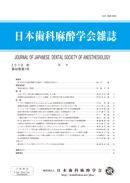Volume 50, Issue 2
Displaying 1-14 of 14 articles from this issue
- |<
- <
- 1
- >
- >|
Review Article
-
2022 Volume 50 Issue 2 Pages 43-51
Published: April 15, 2022
Released on J-STAGE: April 15, 2022
Download PDF (571K)
Original Article
-
2022 Volume 50 Issue 2 Pages 52-65
Published: April 15, 2022
Released on J-STAGE: April 15, 2022
Download PDF (4749K)
Clinical Article
-
2022 Volume 50 Issue 2 Pages 66-69
Published: April 15, 2022
Released on J-STAGE: April 15, 2022
Download PDF (1524K)
Short Communication
-
2022 Volume 50 Issue 2 Pages 70-72
Published: April 15, 2022
Released on J-STAGE: April 15, 2022
Download PDF (314K) -
2022 Volume 50 Issue 2 Pages 73-75
Published: April 15, 2022
Released on J-STAGE: April 15, 2022
Download PDF (238K) -
2022 Volume 50 Issue 2 Pages 76-78
Published: April 15, 2022
Released on J-STAGE: April 15, 2022
Download PDF (301K) -
2022 Volume 50 Issue 2 Pages 79-81
Published: April 15, 2022
Released on J-STAGE: April 15, 2022
Download PDF (256K) -
2022 Volume 50 Issue 2 Pages 82-84
Published: April 15, 2022
Released on J-STAGE: April 15, 2022
Download PDF (576K) -
2022 Volume 50 Issue 2 Pages 85-87
Published: April 15, 2022
Released on J-STAGE: April 15, 2022
Download PDF (277K) -
2022 Volume 50 Issue 2 Pages 88-90
Published: April 15, 2022
Released on J-STAGE: April 15, 2022
Download PDF (405K) -
2022 Volume 50 Issue 2 Pages 91-93
Published: April 15, 2022
Released on J-STAGE: April 15, 2022
Download PDF (209K)
Lectures in Annual Meeting of the JDSA
-
2022 Volume 50 Issue 2 Pages 94-99
Published: April 15, 2022
Released on J-STAGE: April 15, 2022
Download PDF (643K) -
2022 Volume 50 Issue 2 Pages 100-105
Published: April 15, 2022
Released on J-STAGE: April 15, 2022
Download PDF (9057K)
JDSA Annual Refresher Course Lecture
-
2022 Volume 50 Issue 2 Pages 106-109
Published: April 15, 2022
Released on J-STAGE: April 15, 2022
Download PDF (539K)
- |<
- <
- 1
- >
- >|
